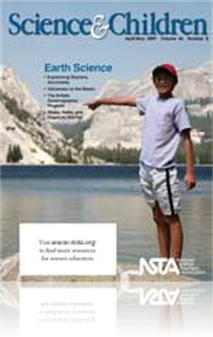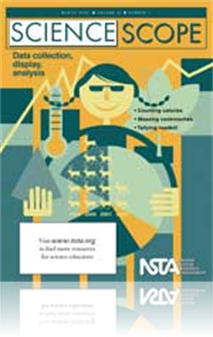All Science and Children resources
Journal Article
Teaching Through Trade Books: Sunrise, Sunset
The next time you watch the Sun rise; take a minute to think about what’s really going on. You are standing on a giant ball of rock that is hurtling through space, and the spot where you are standing is rotating in the direction of a star 93 millio...
Journal Article
Methods and Strategies: Keeping It Real
When teaching science, teachers must ensure that students have meaningful experiences outdoors where they use all their senses to better understand their local and easily observed environment and don’t fall into the habit of relying on computers an...
Journal Article
Perspectives: Societal Issues in Science
When students investigate local issues in science class, they gain research and critical-thinking skills while improving their attitudes toward science. However, since many societal issues are controversial, it is important to create a safe and risk-...
Journal Article
Editor’s Note: Scientists at Work in Earth Science
Working with outside resources almost always strengthens our classrooms. Whether it is taking a trip to a university lab or inviting scientists in, excitement builds as students experience the world of scientists. Whether partnering with scientists o...
Journal Article
Science 101: Why are oceans salty and lakes and rivers not?
For starters, lakes and rivers do contain salt, just not as much as the oceans. A large portion of those salts and minerals washes downstream into other rivers, or through the outlet stream or river of a lake, and eventually winds up in the oceans. S...
Journal Article
Science Shorts: Word Wall Work—Supporting Science Talk
One goal of classroom teachers is for students to develop the ability to recognize and understand the vocabulary of science. Classroom teachers also understand that students “need to keep expanding their understanding of scientific terminology so t...
Journal Article
Science Shorts: About Form and Function
Humans have been classifying organisms since before recorded history, cataloging flora and fauna for our own species’ benefit. Recognition of particular forms—the bark of a tree, shape of a leaf, or color of a mushroom cap—could reveal importan...
Journal Article
Every Day Science Calendar: March 2009
This monthly feature contains facts and challenges for the science explorer....
Journal Article
Teaching Through Trade Books: Pondering Popcorn
When most people hear the word, popcorn, they think of a tasty treat enjoyed at the movies. In this month’s column, popcorn takes center stage as students engage in investigations relating to observations and predictions, as well as conducting an e...
Journal Article
This article describes the experience of a group of first-grade teachers as they tackled the science process of classification, a targeted learning objective for the first grade. While the two-year process was not easy and required teachers to teach ...
Journal Article
Perspectives: Helping Students Understand the Nature of Science
An important goal of science teaching is to help students understand the “nature of science”—what science is and how science works. The nature of science addresses the importance of creativity and imagination in scientific work; how scientists ...
Journal Article
On a recent autumn afternoon at Harmony Leland Elementary in Mableton, Georgia, students in a fifth-grade science class investigated the essential process of classification—the act of putting things into groups according to some common characterist...
Journal Article
Libros de Ciencias en Español: A selection of recent science trade books in Spanish (March 2009)
Simple, lively, and easy-to-understand science books in Spanish for the very young are the new reality in the publishing world. In contrast to previous years where there has been a wider selection of books for beginning, middle, and advanced readers,...
Journal Article
A Land-Use-Planning Simulation Using Google Earth
Google Earth (GE) is proving to be a valuable tool in the science classroom for understanding the environment and making responsible environmental decisions (Bodzin 2008). GE provides learners with a dynamic mapping experience using a simple interfac...
Journal Article
Sheltered Instruction Techniques for ELLs
The suggestions described here to adapt instruction for English Language Learners (ELLs) are based on the concept of sheltered instruction, a model of language-support methods for instruction for ELLs derived primarily through the Sheltered Instructi...




